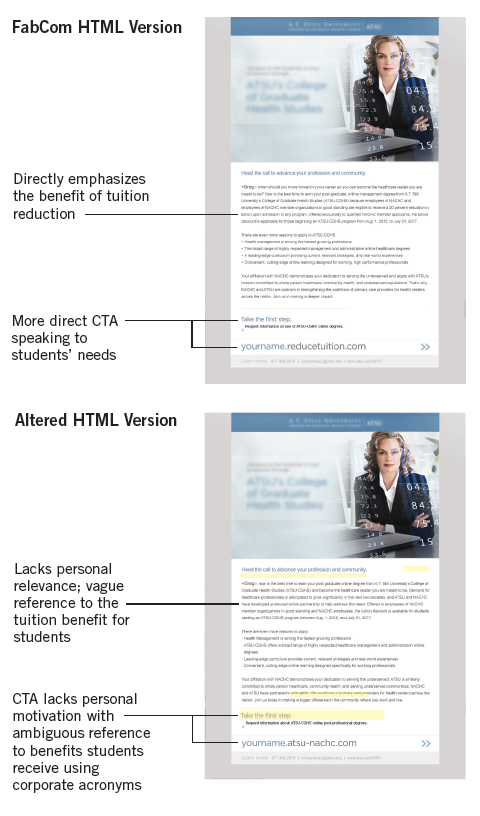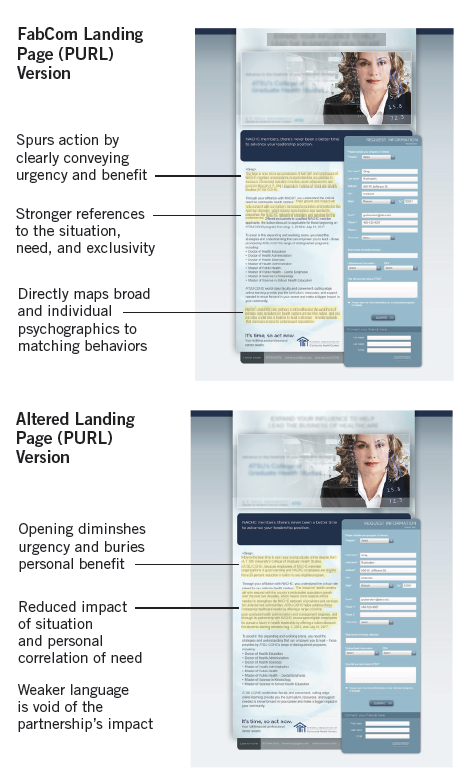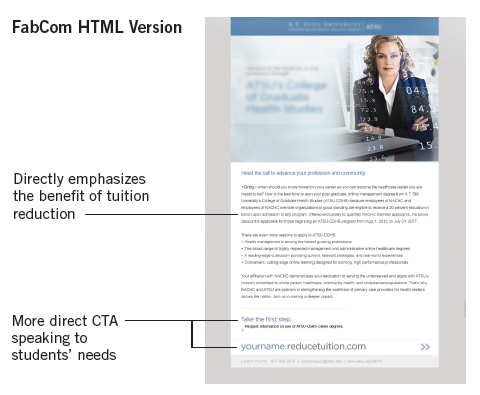Better Advertising ROI with Real Time Analytics and Marketing Intelligence
MEDICAL AND HEALTH SCIENCES UNIVERSITY SPLIT TEST: OPTIMIZING ADVERTISING CAMPAIGNS WITH MARKETING BUSINESS INTELLIGENCE
Situation
FabCom, a Phoenix marketing and advertising agency, has a long-standing relationship with a prominent health sciences university. The University attended a Community Health Association conference as part of their ongoing support for the health centers. The agency was tasked with designing the community health conference marketing campaign; multichannel progressive messaging techniques were deployed to drive traffic from interest into the university call center. Complete with marketing business intelligence, the advertising campaign included an email (HTML) and Personalized URL (PURL), providing a unique and personalized landing page for each post-conference attendee targeted.
GOALS
Dynamic marketing campaign goals:
- Recruit students for the health sciences university’s online programs through the call center.
- Position the University’s educational offers as most relevant to community health employees.
- Deliver at least 10 qualified students to the admissions teams.
OBJECTIVES
- Unite the University’s partnering efforts operationally to deliver maximum marketing value and effectiveness.
- Capture the enthusiasm of NACHC attendees toward the University’s operational efforts to increase receptivity to its respected online programs.

STRATEGY AND TACTICS
Among the key differentiators setting integrated marketing teams apart from most advertising agencies is the ability to align and empower advertising messaging with tools and methods of many disciplines. At FabCom, our ability to leverage progressive messaging techniques and psychological triggers to promote action is powered by foundational differences to ensure results-oriented advertising.
One-to-one marketing campaigns work from within the natural references to the product that propel personal interest based on each user’s (prospect’s) personal perspective. When leveraging progressive messaging properly, the calls to action become a “pay off” to the advertising message. It’s the prospect clicking something they want and then getting exactly what they expect. Neuromarketology™ methods create instant authenticity and inclination from the prospect that this action fits “what I want,” thus influencing more action and more conversions.
The best integrated marketing agencies run split tests whenever possible to optimize advertising results. Below is a split test created when a client desired to make alterations to the proofs:
One of the differences between FabCom and the client-requested version was in the PURL messaging call-to-action address doubling as a personalized link. The key to deciding what would create best advertising conversions is asking, “What’s more motivating to the prospect? What will facilitate more conversions?” With budget in mind, FabCom’s method was designed to create a 220% increase in revenue right to the bottom line.
The client’s internal team wordsmithed elements to reflect its perspective more prominently, leaving a delta in the best thing to say or do for the target cohorts. This delta resulted from internal perceptions vs. outside industry expertise with a different perspective focusing on the personal, target-driven characteristics derived from the mapping of the targets’ demographic, psychographic and behaviors to the product or service attributes.
When the marketing agency received the client changes, the Client Services teams instantly noticed that the personal emotion, resonance, and relevance of the campaign were diminished with the suggested edits. With that concern in mind, the client was contacted and received further explanation surrounding what was initially created and why. The agency also asssured the internal academic stakeholders that the method and content originally created would work best to achieve the goal of the campaign and align with the University’s budgets.
Hence, the final decision to conduct a split test. FabCom would deploy half of the originally configured campaign and the other half as the altered requested version, and compare results. Content would then be adjusted for the campaigns to follow.

RESULTS
The agency leveraged advertising and conversion-marketing strategies empowered by its Neuromarketology methods to drive campaign results. As you can see in the following, FabCom’s recommended version of the campaign produced 220% more bottom line conversion results than the altered version.
Altered Version
Sent: 846
Opened: 199 (23.5%)
Conversions:: 5 (2.0%)
FabCom Recommended Version
Sent: 836
Opened: 210 (25.1%)
Conversions:: 11 (4.3%)
Note: These analytics are based on the leg 1 split test elements only. The balance of the campaign continues to roll out and completely eclipse goals for the advertising campaign.


Conclusion
Trusting the strategic marketing and advertising experts clarifies the creation process to optimize efficiency, quality, results, generate the desired outcome, and maximize advertising spend. The client’s involvement is paramount when providing initial input into what is desired and needed, voicing any concerns and considerations based on their technical knowledge of the product, service or targeted cohorts, as well as providing the necessary approvals for any project. This case study outlines a classic situation that demonstrates the importance of exercising caution when making changes based on internal, operational preferences and perspectives. For an integrated marketing agency partner to perform with its signature agility, it takes an understanding of and appreciation for what needs to be considered to produce the desired results. It also takes trust in a marketing agency that understands how to accomplish win-wins without violating areas of team sanctity and dignity.
That’s precisely why clients have hired FabCom for more than two decades.











